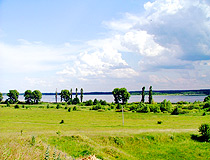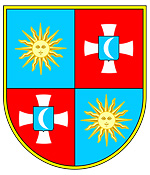Vinnytsia Oblast - Overview
Vinnytsia Oblast or Vinnytska Oblast is an administrative region located in the forest-steppe area of the right-bank part of Ukraine, in the eastern part of Podillia. Vinnytsia is the capital city of the region. In the south-west of the Vinnytsia region, along the Dniester River, there is the state border of Ukraine with the Republic of Moldova (202 km).
The population of the Vinnytsia Oblast (2021) is about 1,510,000 (3.67% of the total population of Ukraine).
The area of Vinnytsia Oblast is 26,492 sq. km. (4.39% of the total area of Ukraine).
Brief History of Vinnytsia Oblast
People settled on the territory of the present Vinnytsia region since ancient times. The mammoth tusk found near the village of Doroshivka is over 22 thousand years old and has the oldest image of a deer in Ukraine. Archaeologists found tools of the Neolithic era, burials of the Bronze Age, remains of the Slavic settlements of the Chernyakhov culture in this territory.
In the 9th century, the Slavic tribes of the Uliches, Buzhans, and Tivertsi, who were part of the old Russian state of Kievan Rus, lived on the lands of the present Vinnytsia region. Over time, this region was annexed to the Principality of Galicia-Volhynia. It was devastated during the Mongol invasion of 1237-1240. The Prince Daniel of Galicia was forced to recognize the dependence of the principality on the Mongols.
In 1362, after the victory of the army of the Lithuanian prince Algirdas over the army of the Golden Horde in the Battle of Blue Waters, Podillia came under the control of the Lithuanian principality. A number of wooden forts were erected along the border of the so-called Wild Field (the lands that remained under the control of the nomads) to protect the hinterland from their raids. These fortifications were the basis for the growth of such towns as Vinnytsia.
Of the numerous versions explaining the origin of the name of Vinnytsia, the most likely ones are based on the following words: “vinnytsia” - a distillery, “Vinnychka” - the name of the river, the Old Slavonic word “vno” - a dowry.
More historical facts…
The rapid growth in the economic importance of Vinnytsia was facilitated by the trade route from Moldova to the Moscow Kingdom. During the times of Ivan III, active trade ties began between the two states.
Since 1569, the territory of the region was part of Poland. In 1598, all government agencies were transferred to Vinnytsia and it became the capital of the Bratslav Voivodeship because the town of Bratslav was more often attacked by the Crimean Tatars, and the restless Zaporizhzhya Sich was also close.
In 1793, as a result of the Second Partition of Poland, the territory of the region became part of the Russian Empire. In 1796, during the formation of the Podolia Governorate, the territory of the region became part of it as the Vinnytsia district. The development of Vinnytsia accelerated after the construction of the Kyiv - Balta - Odesa railway in 1870.
During the Civil War in the territory of the former Russian Empire in 1917-1920, power in the towns and villages of the future Vinnytsia region changed several times. At the end of the war, this territory became part of the Ukrainian Soviet Socialist Republic. On February 27, 1932, Vinnytsia Oblast was formed among the first five oblasts of the Ukrainian SSR. At that time, it occupied the territory of the present Vinnytsia, Khmelnytskyi, and parts of the Zhytomyr regions.
In July 1941, during the Second World War, Vinnytsia Oblast was occupied by the German and Romanian troops. About 12 km from Vinnytsia, the “Werewolf” bunker was built - one of Adolf Hitler’s Eastern Front military headquarters. The region was liberated by the Red Army in March 1944.
In the post-war years, the Vinnytsia region was actively recovering and soon became the leader of the beet-growing and sugar industry of the USSR. Vegetable growing, horticulture, and animal husbandry were also well developed.
In December 1991, after the collapse of the USSR, Vinnytsia Oblast became part of independent Ukraine.
Beautiful nature of Vinnytsia Oblast

Summer in Vinnytsia Oblast
Author: Lyatavskiy

Vinnytsia region landscape
Author: Svetlov

Vinnytsia Oblast scenery
Author: Yuriy Bondarchuk
Vinnytsia Oblast - Features
Most of the territory of Vinnytsia Oblast is located within the Podillia (elevation up to 362 m) and Dnieper (elevation up to 323 m) uplands. The surface of the region is a wavy plain, rising to the northwest and lowering to the south and southeast. The greatest length of the region from east to west is 200 km, from north to south - 185 km.
The climate is temperate continental. Winters are relatively mild, summers are warm and sunny. The average temperature in January is minus 5 degrees Celsius, in July - plus 19 degrees Celsius.
The economy of the Vinnytsia region is mostly focused on the agricultural sector and manufacturing. All leading industries (except for the electric power industry) are directly related to the production of agricultural products, from the production of machinery and fertilizers to the processing of agricultural raw materials. This region takes 1st place in Ukraine in terms of gross sugar and grain production. The soils of the Vinnytsia region are among the most fertile in Europe.
The resort resources of this region, along with a favorable climate, include mineral waters, primarily the radon waters of the Novokhmilnykovskyi deposit, on the basis of which the Khmilnyk resort operates. Other deposits of mineral waters of various chemical compositions have also been discovered in the region.
The geographical position of the Vinnytsia region in the central part of Ukraine is favorable for its general development and for tourism in particular. It also determines the transit importance of this territory. The region is crossed by railways used for interstate communications.
Attractions of the Vinnytsia Region
On the territory of Vinnytsia Oblast there are a lot of preserved old estates with garden and park ensembles, which were the basis for the creation of the first Soviet sanatoriums in 1920-1923, as well as landscape parks, museums, churches, and castles. There are 580 monuments of architecture and urban planning, 1,507 monuments of archeology, 1,660 historical monuments, 98 monuments of monumental art in Vinnytsia Oblast.
The historical settlements of the region are Bar, Bershad, Brailiv, Bratslav, Vinnytsia, Voronovytsya, Haisyn, Dashiv, Zhmerynka, Illintsi, Kozyatyn, Kopaihorod, Mohyliv-Podilskyi, Murovani Kurylivtsi, Nemyriv, Orativ, Pohrebyshche, Sytkivtsi, Tomashpil, Tulchyn, Khmilnyk, Chechelnyk, Sharhorod, Yampil.
The most interesting historical and cultural places and monuments:
- Remains of a Scythian settlement located about 4 km southeast of Nemyriv,
- State Historical and Cultural Reserve “Busha” in the village of Busha,
- Vinnytsia Regional Museum of Local Lore,
- Remains of Hitler’s headquarters “Werewolf”,
- Museum-Estate of N.I. Pirogov in Vinnytsia,
- Wooden churches of St. Nicholas (1746) and St. Yuri (1726) in Vinnytsia,
- Complex of fortified monastery buildings “Mury” (the 17th-18th centuries) in Vinnytsia,
- Remains of the castle in Sharhorod (the 16th century),
- Ruins of castles in Bar, Ozaryntsi, Selyshche, Khmilnyk,
- Places of worship of the 16th-19th centuries in Sharhorod, Brailiv, Nemyriv, Vinnytsia, Mohyliv-Podilskyi,
- Palaces in Tulchyn (the 18th-19th centuries), Nemyriv (the 19th century), Murovani Kurylivtsi (1805),
- Literary and memorial museums of Marco Vovchok and N. A. Nekrasov in Nemyriv.












